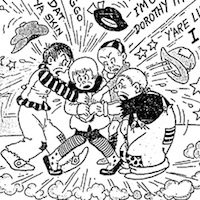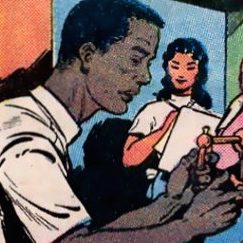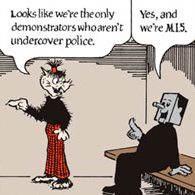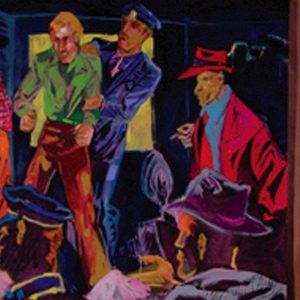The New York Comics & Picture-Story Symposium is a weekly forum for discussing the tradition and future of text/image work. Open to the public, it meets Monday nights 7-9pm EST in New York City. Presentations vary weekly and include everything from historical topics and technical demonstrations to creators presenting their work. Check out upcoming meetings here.
Open to the public, it meets Monday nights 7-9pm EST in New York City. Presentations vary weekly and include everything from historical topics and technical demonstrations to creators presenting their work. Check out upcoming meetings here.
Evan Neely, art historian and professor, gave a talk at the New York Comics Symposium this week, titled Comics’ Belated Modernism, Or, What’s the Matter with Comics? He spoke about comics from an art historical perspective, and how it missed the boat when other art forms leapt into Modernism. He also talked about the unique way in which comics can convey meaning, going into detail about the way it plays with the reader’s sense of time. Neely’s talk, rather than being a singular argument, touched on a number of missed connections between comics and art, leaving the audience with much food for thought. He encouraged the audience to engage him on issues as he spoke, which made for some animated discussions.
Neely began his talk with some comics history. He spoke first about Famous Funnies (1933), which is regarded by many as the first comic book. Before it was published, comics were only read in strip form, which limited them to just a few panels and gags. Comics, he noted, is unlike film in that it moved backwards from color to black and white. In fact, it is the only medium to do so in such a forceful way.
In the early ‘60s, comics entered what is known as the Silver Age, when superheroes became immensely popular. Also around this time, Clement Greenberg’s “Modernist Painting” essay helped craft Modernism into the new lens through which art was viewed. This worldview had no room for comics, which was and often still is viewed as a strange hybrid art form, seemingly antithetical to the purist approach Greenberg espoused.
The ‘70s then saw the rise of Pop Art, the notion of Pluralism, and the publishing of Michael Fried’s essay, “Art & Objecthood”. The issue of reproducibility in art became prevalent via artists like Andy Warhol, with no nod to the fact that comics had been there for decades. Neither did comics reap the benefits of the developing belief that anything can be art, said Neely; they did not enjoy the gallery spotlight until much later than other mediums and are still underrepresented at these venues. An audience member pointed out that comics are often better witnessed in bound or digital form anyway, a point Neely did not deny.
We live in a culture that values verbal discourse more than the visual, but comics may have the power to change that, Neely pointed out. He then asked the question: “Does the form of representation that comics offers us actually allow us to take things seriously that are not in and of themselves significant?” He also supplied an answer: “Yes.”
To Neely, comics did not truly become modernist until the 1990s. He used Alan Moore’s seminal take on the superhero, Watchmen, and Dan Clowes’ satire about the art form and its creators, Pussey!, as examples of comics that subverted the norm and turned a critical eye back onto comics themselves. He also talked about Scott McCloud’s comic about comics, Understanding Comics, and Logicomix, a biography of Bertrand Russell, works that achieved a similar goal by being self-referential, if not satirical.
At this point, Neely shifted the talk to the unique way comics show the passage of time. In Dick Tracy, for example, motion lines were used to show the place a criminal had escaped from, despite the fact that he had done so much earlier.
He then referred to pages from Paul Pope’s Batman: Year 100, a good example of using dynamic images and a frenetic sense of movement to make time seem to speed up. Alan Moore and Eddie Campbell’s From Hell, on the other hand, employs very literal pacing and repetitive compositions, which often seem at odds with their contents, thus giving the reader a sense of discombobulation that adds to the murder mystery plot.
According to Neely, comics are the only medium in which the time that transpires in-story is so radically different from the time it takes to read it. He then showed pages from his own comic, Watching Rome Burn, which employs repeating forms, conventional pacing, and a theatrical style.
Returning to the subject of art history, Neely brought up Robert Smithson’s work, which is often interpreted as a deconstruction of material and technique in art. As with material, subject matter is not necessarily what makes a work meaningful to its audience either. People do not love Monet because they love haystacks; they love his work because of the way he depicted them. Most major galleries are no longer interested in this sort of craft, but it is alive and well in comics.
Neely discussed the return of representation to art via work that deals with identity and race. Representation became a means of “dismantling authenticity”. Meanwhile, so-called “serious” comics and graphic novels like Alison Bechdel’s Fun Home began to sell well and even be taught in colleges. A discussion about comics like Fun Home ensued, the gist of which was that these comics often lean heavily on verbal discourse and autobiography, thus more easily engaging a primarily literary audience.
Lastly, Neely talked about comics’ “limits.” In Understanding Comics, Scott McCloud famously declared that “(the) potential of comics is limitless,” but Neely contends that they suffer from social limitations due to them being so oft dismissed from art galleries. The night concluded with a discussion about the current popularity of “verbally discursive comics,” why comics have been snubbed by intellectuals for so long, and what the future of comics may hold.
***
First image: Pages from Logicomix: An Epic Search for Truth, written by Apostolos Doxiadis and Christos H. Papadimitriou with art by Alecos Papadatos and Annie Di Donna (Bloomsbury USA)
Second image: Chester Gould’s Dick Tracy vs. “The Blank” (January 2, 1938)
Third image (left): A page from Alan Moore and Eddie Campbell’s From Hell (Top Shelf Productions)
Third image (right): A page from Paul Pope’s Batman: Year 100 with colors by José Villarrubia (DC Comics)
Fourth Image: A page from Michael Cleaves’ Watching Rome Burn
_______________
Jess Worby is a visual artist, freelance illustrator, teacher, sometimes curator and cartoonist living in Brooklyn. Keep up with his artistic exploits on everythingisweird.com and his musings on Twitter.




